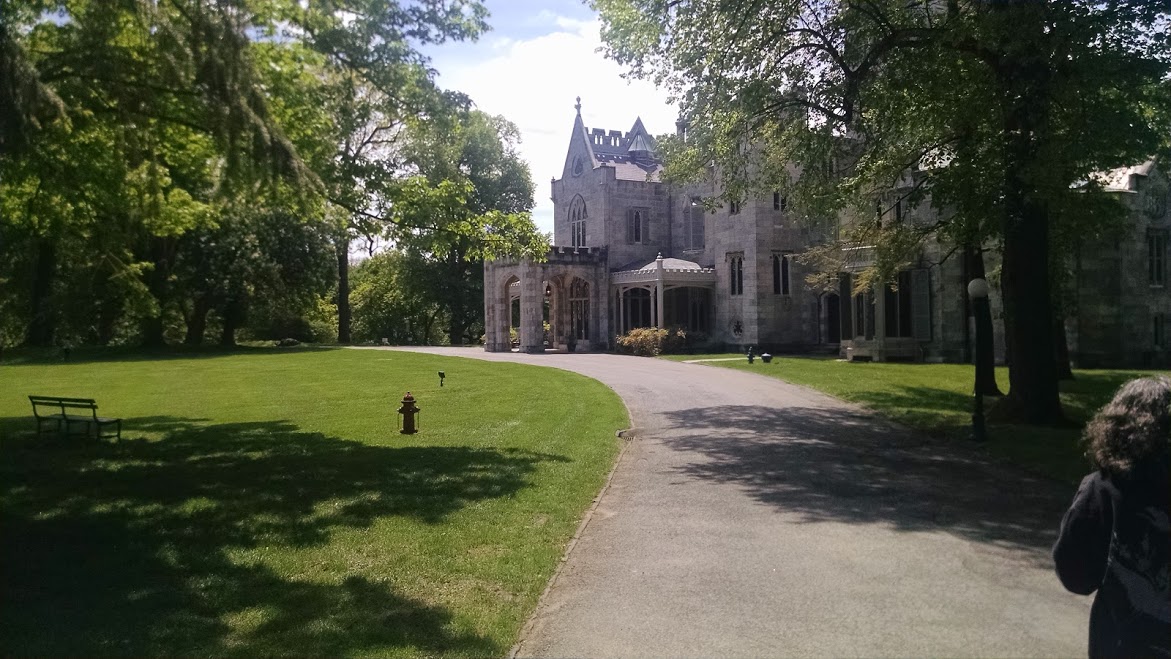Lyndhurst: An American Masterpiece
For our tenth anniversary, my wife and I spent the day in the country, or what city dwellers would have considered to be the country near the turn of the last century (i.e. the Progressive Era). We planned a day trip to the Hudson River to visit Lyndhurst, a Gothic Revival masterpiece. A quaint and quiet adventure.

Lyndhurst and the Hudson River in the distance, Tarrytown, New York (Photograph by Author).
After leaving our modest home in Jersey City, we made our way to Grand Central Station. Although bursting with commuters, tourists, and fellow day trippers, Grand Central Station never ceases to amaze and dazzle. Yes, pausing in the main concourse and gazing at the starry ceiling is a must-do for any visitor. However, I’m more fascinated by the elegant and functional nature of the train station: One can get a shoeshine, a bottle of wine, or a small gift or enjoy a meal or drink at the variety of eateries and restaurants within Grand Central Station. While immersed in its world, one feels deserving of certain status and respect. Simply put, Grand Central Station inspires. And entices me to stray from the intended subject of this post. Back to my original topic …
We purchased tickets, boarded the train, and settled in our seats for a scenic ride along the lower Hudson River Valley. While looking out the window at the legendary waterway, I felt that I was following the footsteps of American painters, writers, and thinkers, venturing into the countryside for refreshment and intellectual rejuvenation.
Since it was a pleasant May day, we walked along the Croton Aqueduct trail after disembarking in Irvington, New York. The trail wound across creeks and roadways, eventually climbing a slight hill. As we neared its crest, we spotted the grey-stoned towers and turrets in the near distance, profiled by verdant trees. Our first glimpse of this American architectural wonder silenced us. Lyndhurst beckoned.
My limited mastery of words and language will absolutely fail to describe Lyndhurst. Thus, my photograph will attempt to suffice.

Lyndhurst, Tarrytown, New York. Perfume Professor at the bottom right (Photograph by Author).
Alexander Jackson Davis designed the mansion for former New York City mayor William Paulding in 1838. Later, the property’s second owner George Merritt contracted Davis to oversee additions following the original style and design and Merritt rechristened the estate Lyndenhurst (hence, the current name). Railroad tycoon Jay Gould purchased the mansion as a summer home in 1880, and it remained in the Gould family until 1961.
The interior of Lyndhurst is full of grand rooms and refined detail. Plaster walls originally were textured and painted to resemble marble–all by hand. Nearly all the furnishings belonged to one of the three former owners of the home. Davis himself designed and produced the furniture for Paulding. The furniture was built not just to fit into a certain room, but for specific spaces in a room. Effectively, every decorative object in the home existed as one element or ingredient in the creation of Lyndhurst. Imagine: daily life consisted of literally walking through art.
Any family member, friend, or casual reader of this blog will know that I love visiting historic homes and spaces. Lyndhurst–in no small part due to our smart, capable, and engaging guide–captured my imagination as few other places have. My mind unwrapped the years, decades, and centuries and pictured the mansion in its nineteenth-century glory. The night silence must have been pure and absolute, an experience utterly unknown to us in an age of automobiles and airplanes. Reading by candlelight or gaslight in the library must have allowed one a concentration impossible among our gadgets and electronics. (Yes, I recognize the irony of writing this on a blog.) Walking down the lawn to the Hudson River on a clear morning, one must have witnessed the total enchantment and beauty of nature and life.
However, the story and provenance of Lyndhurst amazed me even more. In 1961, Jay Gould’s daughter, Anna, Duchess of Talleyrand-Perigord, died and bequeathed the entire estate with its art, furnishings, grounds, and holdings to the National Trust for Historic Preservation. She gave Lyndhurst to the American public to admire and enjoy.
In contemporary America, who of such wealth and status would preserve a building in its architectural brilliance and later deed it to a non-profit organization? Who would see this cultural endowment as their greatest deed, their most lasting legacy?
If you enjoy history, architecture, landscapes, or great story-telling, make a trip to Lyndhurst. Days, possibly weeks later, you’ll still be thinking of your encounter with this breathtaking American masterpiece.
Beautiful